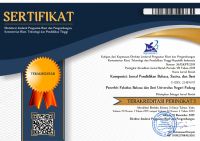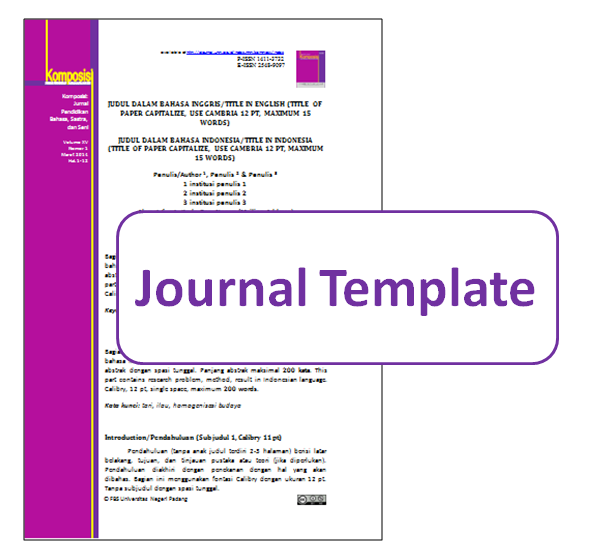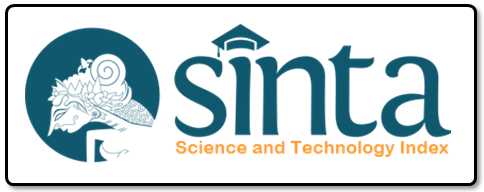MALL IN LEARNING ENGLISH GRAMMAR FOR HIGHER EDUCATION STUDENTS
Nur Rosita, Nora Fudhla, Bayu Hadi Saputro
Abstract
The 21st century learning trend with mobile devices has made significant impacts on the educational setting. It promotes students’ autonomous learning attitude to have their own learning setting anytime, anywhere, and in any way as the purpose of lifelong learning. It is also applied to build students’ 21st century skills known as 4-Cs; collaboration, communication, critical thinking, and creativity as well as digital literacy. On the other hand, there are some questions and concerns being echoed around the matter of balancing pedagogy and technology on the grammar learning content for university level students. This article is a part of developmental research that focuses on an analysis of the principles and features of mobile technology support tools for learning English grammar in higher education. A questionnaire using online Google form is administered to the 79 students to see their perspective on learning grammar in 21st century mode. Further, the data are gathered in qualitative-descriptive method to find the appropriate criteria. This study meets a basic model preference to build a MALL-Based educational app that can support English grammar learning in Universitas Negeri Padang. It can be concluded that the MALL for grammar should cover all teaching-learning elements like sources and assessments.
Keywords
mobile assisted language learning (MALL), learning English grammar, higher education
References
Ahmad, K. S., Sudweeks, F., & Armarego, J. (2015). Learning English vocabulary in a Mobile Assisted Language Learning (MALL) environment: A sociocultural study of migrant women. Interdisciplinary Journal of e-Skills and Life Long Learning, 11, 25-45. Retrieved from http://www.ijello.org/Volume11/IJELLv11p025- 045Ahmad1566.pdf
Alismail, H.A. & McGuire, P. (2015). 21st Century Standards and Curriculum: Current Research and Practice. Journal of Education and Practice. 6 (6), 150-155
Baleghizadeh, S and Oladrostam, E. (2011). The Effect of Mobile Assisted Language Learning
(MALL) on Grammatical Accuracy of EFL Students* Special issue: The Internet and
Technology in EFL/ESL.
Chuang, Yung-Ting. 2015. SSCLS: A Smartphone-Supported Collaborative Learning System. Telematics and Informatics. Volume 32, Issue 3, August 2015, Pages 463-474
Fitrawati. 2017. Do Students Need Multimedia Based Grammar 3 Teaching Material?. Linguadidaktika. Vol. 11, No. 1, 2017, pp. 111-122
Ganapathy, M, Shuid M., & Azizan, A.N. (2016). Malaysian ESL Students’ Perceptions on the Usability of a Mobile Application for Grammar Test: A Case Study of ESL Undergraduates in Universiti Sains Malaysia. 3L: The Southeast Asian Journal of English Language Studies. 22 (1), 127-140. DOI: 10.17576/3L-2016-2201-10
Hazaea, A.N. & Alzubi, A.A. (2016). The Effectiveness of Using Mobile on EFL Learners’ Reading Practices in Najran University. Received: February 14, 2016 Accepted: April 2, 2016 Online Published: April 5, 2016 doi: 10.5539/elt.v9n5p8 URL: http://dx.doi.org/10.5539/elt.v9n5p8
Kim, H.S. (2013). Emerging Mobile Apps to Improve English Listening Skills. Multimedia-Assisted Language Learning. 16(2), 11-30
Kivunja, C. (2014). Innovative Pedagogies in Higher Education to Become Effective Teachers of 21st Century Skills: Unpacking the Learning and Innovations Skills Domain of the New Learning Paradigm. International Journal of Higher Education. 3 (4)
Ovilia, R. & Asfina, R. (2017). 21st Century Learning: Is ICT Really Integrated in EFL Classroom or Merely Segregated Outside the Classroom?. EnJourMe Journal. 2 (1), 1-17.
Scott, C.L. (2015). THE FUTURES of LEARNING 3: What kind of pedagogies for the 21st century?. UNESCO Education Research and Foresight. [ERF Working Papers Series, No. 15]. http://unesdoc.unesco.org/images/0024/002431/243126e.pdf
Simonova, I & Netolicka, J. (2017). Teaching and Learning English at Grammar School Supported by Mobile Touch Technologies. ICTE Journal, 6(1), 61-69 DOI: https://doi.org/10.1515/ijicte-2017-0006 https://content.sciendo.com/view/journals/ijicte/6/1/article-p61.xml
Sugeng, B. (2015). Need for Increasing Grammar Focus in English Teaching: A Case in Indonesia. Journal of Education and social research. Vol 5(4), 131- 138
Sung, Y.T., Lan, Yu-Ju, and Kuo-En Chang. 2007. A Mobile-Device-Supported Peer-Assisted Learning System for Collaborative early EFL Reading. Language Learning & Technology, Vol. 11, p. 130 – 151
Zaki, A.A. & Yunus, M.M. (2015). Potential of Mobile Learning in Teaching of ESL Academic Writing. English Language Teaching Journal. 8(6), 11-19
DOI:
https://doi.org/10.24036/komposisi.v20i1.102282
Refbacks
There are currently no refbacks.
Copyright (c) 2019 Komposisi: Jurnal Pendidikan Bahasa, Sastra, dan Seni
This work is licensed under a
Creative Commons Attribution-NonCommercial 4.0 International License .
Komposisi: Jurnal Pendidikan Bahasa, Sastra, dan Seni , a peer-reviewed online journal in languages, literature, and arts education.
Printed ISSN 1411-3732 , Online ISSN 2548-9097 .
Currently, Komposisi: Jurnal Pendidikan Bahasa, Sastra, dan Seni is indexed by: View My Stats
Visitors since February 2017:
<div class="statcounter"><a title="web analytics" href="http://statcounter.com/" target="_blank"><img class="statcounter" src="//c.statcounter.com/11239717/0/d5796c6b/0/" alt="web analytics"></a></div> View My Stats
Published by:
Universitas Negeri Padang (UNP) Address: Faculty of Languages and Arts (FBS) Universitas Negeri Padang. Jl Prof. Dr. Hamka Air Tawar Barat, Padang - West Sumatera -Indonesia Telp/Fax. +62751 7053363 Home page: http://ejournal.unp.ac.id/index.php/komposisi | e-mail:komposisi.fbsunp @ fbs.unp.ac.id | cc: havid_a @ fbs.unp.ac.id
Server Luar
slot88
King Wood Car Care slot gacor
scam
situs toto
bandar togel
bandar togel
Slot Gacor Hari ini
situs toto
situs toto
toto togel
togel online
topup murah
harapan777
AMDBET
toto togel
slot88
login bayar4d
macau303
slot resmi apk slot online Slot Maxwin
situs toto
sakti55
situs toto felix168
nextogel
NEXTOGEL
NEXTOGEL
NEXTOGEL
NEXTOGEL
NEXTOGEL
NEXTOGEL
NEXTOGEL
NEXTOGEL
NEXTOGEL
NEXTOGEL
NEXTOGEL
NEXTOGEL
NEXTOGEL
NEXTOGEL
NEXTOGEL
NEXTOGEL
NEXTOGEL
NEXTOGEL
NEXTOGEL
NEXTOGEL
NEXTOGEL
NEXTOGEL
NEXTOGEL
NEXTOGEL
NEXTOGEL
NEXTOGEL
NEXTOGEL
NEXTOGEL
NEXTOGEL
NEXTOGEL
NEXTOGEL
JEPETOGEL
JEPETOGEL
JEPETOGEL
JEPETOGEL
KIM369
KIM369
KIM369
KIM369
KIM369
KIM369
KIM369
KIM369
KIM369
KIM369
situs toto toto slot kuntogel
situs toto toto slot sendok88
togel online toto slot https://www.eaglehighplantations.id/
toto macau
slot gacor slot gacor
batak5d toto slot Slot88 www.onscripture.com
slot online
situs toto
situs gacor bandar togel resmi toto togel https://montreallawfirm.com
wild west gold sering pecah
Toto 4D
slot88
toto macau
Situs Toto
Situs Toto
https://mercubuana.org/
Toto 4d
toto 4d
Toto 4D
toto 4d
info rtp akurat malam ini
Wanita Subang Beli mobil dari Nolimit city
rahasia Cuan Aztech Gems
Gatot kaca Buat TKW Jadi jutawan
Rahasia sukses bermain Mahjing wins
harapan princess starlight
Harapan sweet bonanza
taktik gates of olympus xmas
dukungan gates olympus
rahasia sukses bermain mahjong ways
Situs togel
slot gacor 2025
luxury89
Sulebet
sulebet
oja89
basic4d
situs toto togel online
vipbet888
momo128 login
https://garudafood.org/
jpmania mesin128
mesin128
mesin128
oja89
slot gacor
jumat4d slot login
https://pintu-pro.id/
slot gacor
Buat yang suka cari link slot gacor hoki69 maxwin tiap hari, ini tempat yang paling sering gue datengin.
choicehomecontractors.com
sarangslot
slot 4d gacor hari ini
Toto 4D
https://up2m.pkr.ac.id/jepangbet/
slot
simpatitogel
slot gacor hari ini
slot gacor
slot
https://unesa.id/
xl bola
slot gacor
vega168
Togel 4D












